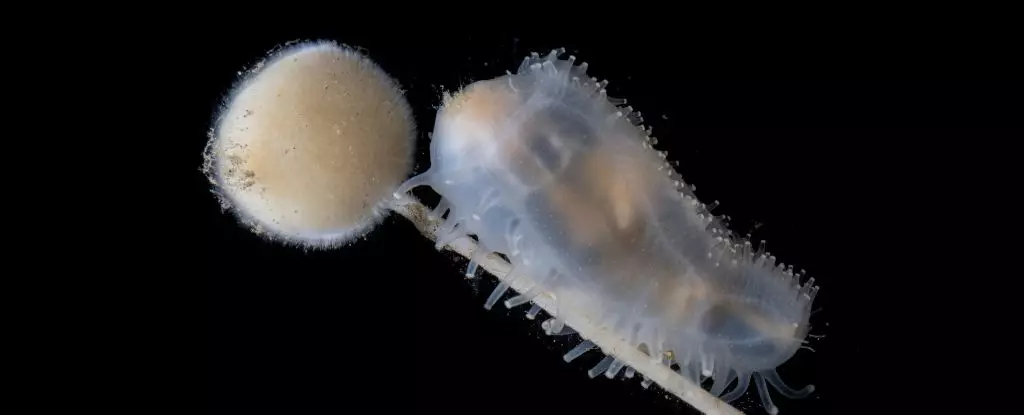A groundbreaking maritime expedition has unveiled breathtaking glimpses into an ecosystem that has long eluded scientists: the hidden worlds surrounding hydrothermal vents in the South Sandwich Islands. This eclectic mix of underwater marvels was explored aboard the Schmidt Ocean Institute’s research vessel, Falkor (too). An international team of tenacious scientists embarked on this 35-day voyage with a singular mission in mind: to document marine biodiversity before it’s irrevocably threatened by climate change and deep-sea mining practices. Positioned near Antarctica, this scarcely populated island chain features the Southern Ocean’s deepest trench, symbolizing a last frontier for scientific inquiry.
Throughout their expedition, the crew battled formidable challenges, including seismic tremors, hurricane-force gales, and colossal waves. Yet, despite these daunting obstacles, their efforts were richly rewarded with extraordinary findings that are likely to reshape our understanding of marine ecosystems. Among the standout moments, the team captured world-first footage of a live colossal squid, dramatic enough to capture public imagination. However, it is the lesser-known discoveries that compel deeper reflection.
Revelations Beneath the Surface
One particularly enchanting discovery was the vibrant vermillion coral garden thriving on the Humpback Seamount, situated close to the region’s shallowest hydrothermal vents approximately 700 meters deep. The spectacle of life surrounding these underwater structures is nothing short of mesmerizing. Towering vent chimneys, some standing at heights comparable to a small building, were adorned with diverse marine life, showcasing nature’s resilience and adaptability in the harsh conditions of the deep sea.
Drones of shrimp adorned the area like flashes of fireworks, darting around these colossal formations, which become lifelines for myriad marine organisms. The fact that these hydrothermal vents on the northeast side of the Quest Caldera had never been explored before evokes a sense of profound anticipation for future expeditions. Jenny Gales, a hydrographer from the University of Plymouth, encapsulated the excitement perfectly: “Discovering these hydrothermal vents was a magical moment, as they have never been seen here before.”
A Close Encounter with the Unknown
The expedition didn’t just stop at stunning geological formations. The scientists documented peculiar species, many of which have functionalities and evolutionary strategies that stretch our understanding of marine biology. A blackwater photographer, Jialing Cai, captured a delicately beautiful nudibranch at a staggering 268 meters deep, while another unsettling scene revealed a grenadier fish, host to parasitic copepods nestling in its gills—an unsettling but riveting glimpse at life’s darker side.
One captivating specimen featured was a stout sea cucumber discovered at an impressive depth of 650 meters. This marine oddity, with what appeared to be a mouthful of a peculiar organism that could be dubbed a “deep-sea puffball,” serves as a reminder of how many secrets the ocean still holds. Yet perhaps the most astonishing sight was that of the elusive Akarotaxis aff. gouldae, a dragonfish that has successfully evaded documentation for two years since its discovery.
Moreover, the sighting of snailfish eggs attached to black coral presents an unexpected finding that no marine biologist had documented until this expedition. Such revelations elevate our understanding of the ecosystem’s complexity, challenging existing theories and sparking curiosity for further exploration.
Preserving Oceanic Treasures
As the expedition revealed, the ocean is a treasure trove of biological diversity, and these findings underscore the urgent need for scientific inquiry and conservation. Marine biologist Michelle Taylor, who leads the Ocean Census project, articulated a compelling case for exploration, stating: “This expedition has given us a glimpse into one of the most remote and biologically rich parts of our ocean.” Her words resonate as a clarion call; our oceans are both incredibly rich in life and exceedingly vulnerable.
The mission of the Ocean Census is not merely to catalog life forms but to advocate for their preservation before environmental calamities obliterate them. The breathtaking ecosystems housed within hydrothermal vents hold more than just scientific interest; they are vital components of our planet’s health and biodiversity. As knowledge accumulates, so too does the responsibility to protect these extraordinary underwater realms for future generations.
The wonders unveiled during such daring expeditions remind us that our planet’s mysteries are far from fully understood, and every discovery holds the potential to transform our perception of life in the depths of the ocean.

